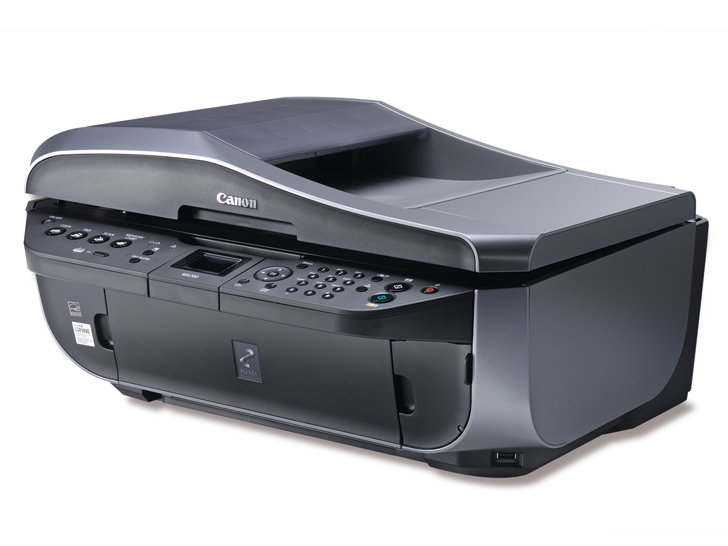TechRadar Verdict
The inclusion of an Ethernet port makes the MX700 a great shared printer and scanner for small workgroups
Pros
- +
Phenomenal value
- +
Ability to share printer scanner over network
- +
Lots of useful features
- +
Very good quality prints and scans
Cons
- -
No duplex
- -
Fax from PC is Windows-only
Why you can trust TechRadar
Frankly, we’re stumped. We just can’t work out how Canon has stuffed so much functionality into this, its flagship MX all-in-one. Scanner, printer, copier, fax, document feeder, two paper inputs, memory card slots, colour screen and Ethernet are all present, and it’s all styled with understated flair.
It’s easy to use, too – the only time we had to delve into the manual was when setting up the printer to operate on a network. It is bulky, however, at almost half a metre wide and not much less deep.
Phenomenal value
You forget that when you look at the specs and the price, though; £131 for a device of this richness is phenomenal value. And because it uses Canon’s admirable ink system (individual tanks for the four ink colours, plus a replaceable ink head), its running costs are competitive, too. If you churn out hundreds of pages a week, a laser printer is still going to be more economical, but the flexibility of the MX700’s photo-capable inkjet system still makes it a top all-rounder.
Print quality is up to Canon’s usual high standards. Text is crisp, and photo reproduction, although guilty of Canon’s tendency to over-saturate, is very good. We did notice some occasional banding, and full ink coverage on plain paper does tend to make the sheets a little floppy before they dry properly, but, in general, things are impressive.
With documents, we were getting a little over seven pages per minute, an A4 photo took a couple of minutes on best quality photo paper and a 6x4-inch borderless print dropped into the output tray in 46 seconds; none of these speeds – recorded over a network, not USB – are uniquely fast, but they’re respectable.
Scan quality is in line with expectations. Consumer scanners can be a little soft, but the rich (if ugly) scanner driver gives options for sharpening, as well as colour curve and balance controls.
The copier works brilliantly, too, and there are options for special scans such as tiling four pages onto one or producing collated copies from separate sheets. There’s also a great feature called Frame Erase; normally, if you copy, say, a novel’s cover, you’d get a sheet that has the novel in one corner with the rest of the sheet covered in black because the thickness of the book has stopped the light being reflected back from the scanner cover.
Frame Erase intelligently removes this – a great saving in ink. There’s a 30-sheet document feeder, too; it’s a little sluggish – a 20-page mono copy from the ADF took almost seven minutes, so not quite reaching 3ppm – but very useful nonetheless.
The fax works well, and there’s a 40-position speed dial list. Text entry using the numeric keypad is a little frustrating, but you’ll only be doing this when setting up your phone book. Annoyingly, only Windows users can fax directly from their PCs; us Mac users have to print a physical copy and then fax it.
Ethernet speeds
So far, so unsurprising. But the MX700’s little treat is that it includes an Ethernet port. Once configured for your network – and it took us days to realise that the reason we couldn’t configure the device was down to the wireless access point we were using – it’s a joy to use. Not only can you share the printer across the network, but the scanner can be accessed, too.
As well as initiating scans from your Mac – a feature that refused to work in Leopard, although it was happy under Tiger – you can walk up to the MX700, select Scan, then pick which of the computers on the network you want to send the flatbed or ADF scan to. You’re then given an option of either saving it as a PDF or attaching it to an email. Sheer genius.
Although it features two input trays and Canon’s toggle for switching between them (a setting that can be overridden in the driver), there’s no duplex in this model, and that’s annoying for a machine otherwise so well suited to an office environment. The screen’s a little pokey, too, particularly when printing photos from a memory card.
Neither quibble, though, takes away from this machine’s charms. It’s a superb choice for a small office.
The TechRadar hive mind. The Megazord. The Voltron. When our powers combine, we become 'TECHRADAR STAFF'. You'll usually see this author name when the entire team has collaborated on a project or an article, whether that's a run-down ranking of our favorite Marvel films, or a round-up of all the coolest things we've collectively seen at annual tech shows like CES and MWC. We are one.
